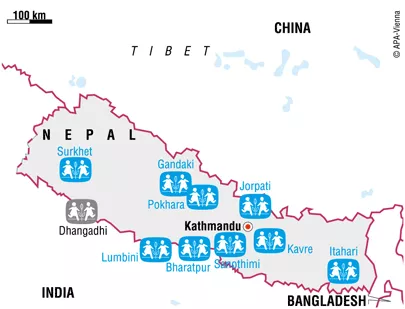
SOS relies on the kindness and generosity of Canadians to be able to provide a home for the most vulnerable children around the world.
By becoming a child sponsor you are helping an individual child in need.
(You will receive a Canadian charitable tax receipt)
Please help us ensure a loving home for every child. Sponsor a child in Asia now.
For just $36/month you can sponsor a child and help provide an orphaned or abandoned child with:
- A safe and nurturing home
- A loving SOS mother
- Quality education
- Healthcare
- Nutritious food
- Clothing and toys
- All the things necessary for a bright future
SOS Children's Villages in Nepal
The unfavourable economic conditions and the lack of medical and educational facilities have meant that SOS Children's Villages has been very active supporting local communities in Nepal. The SOS Social Centres have provided family strengthening programmes, which work with local agencies to enable children who are at risk of losing the care of their family to grow up in a caring environment. When children can no longer stay with their families, they are cared for by their SOS mothers in one of the SOS families with other orphaned and abandoned children.

Young children can attend the SOS kindergartens, while their carers earn a living or receive training. There are eight SOS Hermann Gmeiner schools, which educate children at both primary and secondary level. Young adults can live in special accommodation where they are guided on their path to an independent life with the help of professionals. The SOS medical facilities provide vital medical advice and treatment in a country where health care is not widely available.
SOS Children's Villages has been present in Nepal since the late 1960s. The work of the organisation first started near the capital city of Kathmandu. SOS Children's Villages has also worked with the exiled Tibetan community since the 1970s with programmes in the Pokhara valley. At present there are nine SOS Children's Villages in Nepal, eight SOS Youth Facilities, one SOS Kindergarten, seven SOS Hermann Gmeiner Schools, one SOS Vocational Training Centre, eight SOS Social Centres with family-strengthening programmes and one SOS Medical Centre.
Some facts about Nepal
The Federal Democratic Republic of Nepal is located in the Himalayas in South Asia. Nepal has a population of around 29.4 million (July 2011 est.); the largest city is the capital Kathmandu, which is home to 990,000. Only one fifth of the population lives in urban areas, though this is changing rapidly as more people move away from deprived rural areas.
After a nation-wide election in 2008, the newly formed Constituent Assembly declared Nepal a federal democratic republic and abolished the monarchy. In spite of suffering rapid political changes in the past decades, Nepal has retained its diverse culture; though it was officially declared a secular state in 2006, there is a strong influence from both Hinduism and Buddhism.
One of the least developed countries in the world
The recent political, social and economic changes in Nepal have had a negative effect on the lives of the people. In 1996 the Maoist rebels started a ten-year campaign which left around 12,000 people dead and 100,000 people displaced; the country is slowly recovering from this long and violent conflict.
Nepal is one of the least developed countries in the world. Agriculture is the mainstay of the economy, providing a livelihood for approximately three quarters of the population. About one fifth of the population works in the service sector and only seven per cent in manufacturing which includes the processing of the locally produced agricultural goods and the creation of carpets and textiles. Tourism is an increasingly important source of income and employment, though the numbers have remained relatively low due to political instability.
Over half of the population lives under the international poverty line of 1.25 US dollars a day. About 78 per cent lives on less than two US dollars a day. Unemployment is high at 46 per cent, but it is estimated that many more are underemployed. A large number of people have moved abroad to work, sending money remittances back to their families in Nepal. These form an important contribution to the Nepalese economy.
Demographically speaking, Nepal is a young country due to the combination of a high fertility rate and a low life expectancy rate of 66 years. Poverty and the lack of access to health care result in thousands of people dying each year due to malnutrition and communicable diseases. HIV/AIDS is an increasing concern, 64,000 people died from the illness in 2009 - poverty, illiteracy, gender inequality and the low educational level compound the epidemic's effects.
Situation of the children in Nepal
There are around 12.7 million children under the age of 18 in Nepal. In recent decades the number of Nepali orphaned and abandoned children without parental care, or at risk of losing such care, is increasing. There are various reasons for this rise including political unrest (particularly armed conflict), the high rate of poverty and the spread of HIV/AIDS.
According to a UNICEF study, the most vulnerable children in Nepal also include those with disabilities, those living in violent and abusive families, street children and those involved in child labour. It is estimated that around 34 per cent of children between the ages of five and 14 are forced to work. These children can be found working as domestic workers, in commercial sexual exploitation or in stone quarrying. Over half of children under the age of 18 are married.
The school enrollment rate is low at about 60 per cent and the drop-out rate is high, which means that a large number of children do not receive an education. The literacy rate among adults remains low: only 69 per cent of men and 42 per cent of women are able to read.
Our Impact
Image
The SOS Children's Village in Nepal provides loving homes to orphaned and abandoned children |
9 VILLAGES | 1164 Orphaned and Abandoned Children |
Image
The SOS Youth Facilities in Nepal provides youth with a loving environment where they learn to transition into independent living and to expand their education |
8 YOUTH FACILITIES | 609 Youths in our Care |
Image

The SOS Kindergarten in Nepal are a fundamental building block for the early development needs including, intellectual and social skills for children. |
1 KINDERGARTENS | 64 Kindergarten students |
Image

SOS Vocational Training Centres in Nepal provide young adults from our youth centres, SOS villages and the surrounding community with the skills they will need to secure reliable employment. They provide realistic job opportunities for the future and an avenue to independence. |
3 VOCATIONAL TRAINING CENTRES | 1114 Youth and adult students |
Image

SOS Social Centres in Nepal aim is to help families, in particular women and children, living in communities neighbouring the SOS Children's Villages to gradually escape from poverty, and to help young people become self-reliant. |
9 SOCIAL CENTRES | 10132 Beneficiaries |
Image

SOS Medical Centres in Nepal provide quality health care to the children in our care, our staff, our staffís family as well as people in the surrounding community. |
1 MEDICAL CENTRES | 8957 Patients |
Our Impact









